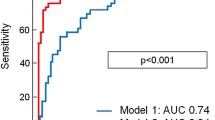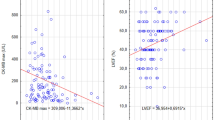Abstract
In this pilot study, we compared the infarct and edema size in acute myocardial infarction (MI) patients treated by nicorandil with those treated by nitrate, using cardiac magnetic resonance (CMR) imaging. Fifty-two acute MI patients who underwent emergency percutaneous coronary intervention (PCI) were enrolled, and were assigned to receive nicorandil or nitrate at random just before reperfusion. For the assessment of infarct and edema areas, short-axis delayed enhancement (DE) and T2-weight (T2w) CMR images were acquired 6.1 ± 2.4 days after the onset of MI. A significant correlation was observed between the peak creatinine kinase (CK) level and the infarct size on DE CMR (r = 0.62, p < 0.05), as well as the edema size on T2w CMR (r = 0.70, p < 0.05) in patients treated by nicorandil (28 patients). A similar correlation was seen between the peak CK level and the infarct size on DE CMR (r = 0.84, p < 0.05), as well as the edema size on T2w CMR (r = 0.84, p < 0.05) in patients treated by nitrate (24 patients). The maximum CK level was significantly lower in patients treated by nicorandil rather than nitrate (1991 ± 1402, 2785 ± 2121 IU/L, respectively, p = 0.03). Both the edema size on T2w CMR and the infarct size on DE CMR were significantly smaller in patients treated by nicorandil rather than nitrate (17.7 ± 9.9, 21.9 ± 13.7 %; p = 0.03, 10.3 ± 6.0, 12.7 ± 6.9 %, p = 0.03, respectively). The presence and amount of microvascular obstruction were significantly smaller in patients treated by nicorandil rather than nitrate (39.2, 64.7 %; p = 0.03; 2.2 ± 1.3, 3.4 ± 1.5 cm2; p = 0.02, respectively). Using CMR imaging, we demonstrated that the complementary use of intravenously and intracoronary administered nicorandil during PCI favorably acts more on the damaged myocardium after MI than nitrate. We need a further powered prospective study on the use of nicorandil.




Similar content being viewed by others
Abbreviations
- CMR:
-
Cardiac magnetic resonance
- DE:
-
Delayed enhancement
- T2w:
-
T2 Weight
- MI:
-
Myocardial infarction
- PCI:
-
Percutaneous coronary intervention
- CK:
-
Creatinine kinase
- MB:
-
Myocardial band isoenzyme
- MVO:
-
Microvascular obstruction
- ATP:
-
Adenosine triphosphate
- GMP:
-
Guanosine monophosphate
References
Angioplasty Substudy Investigators (1997) A clinical trial comparing primary coronary angioplasty with tissue plasminogen activator for acute myocardial infarction. The global Use of Strategies to Open occluded coronary arteries acute coronary syndromes (GUSTO IIb). N Engl J Med 336(23):1621–1628
Taniyama Y, Ito H, Iwakura K, Masuyama T, Hori M, Takuichi S, Nishikawa N, Higashino Y, Fujii K, Minamoto T (1997) Beneficial effect of intracoronary verapamil on microvascular and myocardial salvage in patients with acute myocardial infarction. J Am Coll Cardiol 30:1193–1199
Sakata Y, Kodama K, Komamura K, Lim YJ, Ishikura F, Hirayama A, Kitakaze M, Masuyama T, Hori M (1997) Salutary effect of adjunctive intracoronary nicorandil administration on restoration of myocardial blood flow and functional improvement in patients with acute myocardial infarction. Am Heart J 133:616–621
Taira N (1989) Nicorandil as a hybrid between nitrates and potassium channel activators. Am J Cardiol 63:18J–24J
Ito H, Taniyama Y, Iwakura K, Nishikawa N, Masuyama T, Kuzuya T, Hori M, Higashino Y, Fujii K, Minamino T (1999) Intravenous nicorandil can preserve microvascular integrity and myocardial viability in patients with reperfused anterior wall myocardial infarction. J Am Coll Cardiol 33:654–660
Okamura A, Rakugi H, Ohishi M, Yanagitani Y, Shimizu M, Nishi T, Taniyama Y, Asai T, Takiuchi S, Moriguchi K, Ohkuro M, Komai N, Yamada K, Inamoto N, Otsuka A, Higaki J, Ogihara T (2001) Additive effects of nicorandil on coronary blood flow during continuous administration of nitroglycerin. J Am Coll Cardiol 37:719–725
Lima JA, Judd RM, Bazille A, Schulman SP, Atalar E, Zerhouni EA (1995) Regional heterogeneity of human myocardial infarcts demonstrated by contrast-enhanced MRI. Potential mechanism. Circulation 92:1117–1125
Judd RM, Lugo-Olivieri CH, Arai M (1995) Physiological basis of myocardial contrast enhancement in fast magnetic resonance images of 2-day-old reperfused canine infarcts. Circulation 92:1902–1910
Friedrich MG, Abdel-Aty H, Taylor A, Schulz-Menger J, Messroghli D, Dietz R (2008) The salvaged area at risk in reperfused acute myocardial infarction as visualized by cardiovascular magnetic resonance. J Am Coll Cardiol 51:1581–1587
Eitel I, Friedrich MG (2011) T2-weighted cardiovascular magnetic resonance in acute cardiac disease. J Cardiovasc Magn Reson 13:13
Manka R, Kozerke S, Rutz AK, Stoeck CT, Boesiger P, Schwitter J (2012) A CMR study of the effects of tissue edema and necrosis on left ventricular dyssynchrony in acute myocardial infarction: implications for cardiac resynchronization therapy. J Cardiovasc Magn Reson 14:47
Miller S, Herber U, Kramer U, Hahn U, Carr J, Stader NI, Hoffmeister HM, Claussen CD (2001) Subacute myocardial infarction: assessment by STIR T2-weighted MR imaging in comparison to regional function. Magma 13:8–14
Lim TH, Hong MK, Lee JS, Mun CW, Park SJ, Ryu JS, Lee JH, Chien D, Laub G (1997) Novel application of breath-hold turbo spin-echo T2 MRI for detection of acute myocardial infarction. J Magn Reson Imaging 7:996–1001
Yamada K, Isobe S, Suzuki S, Kinoshita K, Yokouchi K, Iwata H, Oshima S, Hirai M, Sawada K, Murohara T (2012) Diagnostic usefulness of the oedema-infarct ratio to differentiate acute from chronic myocardial damage using magnetic resonance imaging. Eur Radiol 22:789–795
Davis KL, Mehlhorn U, Laine GA, Allen SJ (1995) Myocardial edema, left ventricular function, and pulmonary hypertension. J Appl Physiol 78:132–137
Pratt JW, Schertel ER, Schaefer SL (1996) Acute transient coronary sinus hypertension impairs left ventricular function and induces myocardial edema. Am J Physiol 271:H834–H841
Kato D, Takashima H, Waseda K, Kurita A, Kuroda Y, Kosaka T, Kuhara Y, Ando H, Maeda K, Kumagai S, Sakurai S, Suzuki A, Toda Y, Watanabe A, Sato S, Fujimoto M, Mizuno T, Amano T (2014) Feasibility and safety of intracoronary nicorandil infusion as a novel hyperemic agent for fractional flow reserve measurements. Heart Vessels. doi:10.1007/s00380-014-0508-5
Sueda S, Miyoshi T, Sasaki Y, Sakaue T, Habara H, Kohno H (2014) Safety and optimal protocol of provocation test for diagnosis of multivessel coronary spasm. Heart Vessels. doi:10.1007/s00380-014-0591-7
Ishii H, Ichimiya S, Kanashiro M, Amano T, Imai K, Murohara T, Matsubara T (2005) Impact of a single intravenous administration of nicorandil before reperfusion in patients with ST-segment-elevation myocardial infarction. Circulation 112:1284–1288
Ryan TJ, Anderson JL, Antman EM (1999) ACCAHA Guidline for the management of patients with acute myocardial infarction: executive summary and recommendations: a report of the American College of Cardiology/American Heart Association Task Force on practice guidelines (Committee on management of acute myocardial infarction). Circulation 100:1016–1030
Wu KC, Zerhouni EA, Judd RM, Lugo-Olivieri CH, Barouch LA, Schlman SP, Blumenthal RS, Lima JAC (1998) Prognostic significance of microvascular obstruction by magnetic resonance imaging in patients with acute myocardial infarction. Circulation 97(8):765–772
Lund GK, Stork A, Saeed M, Bansmann MP, Gerken JH, MullerV Master J, Higgins CB, Adam G, Meinertz T (2004) Acute myocardial infarction: evaluation with first-pass enhancement and delayed enhancement MR imaging compared with 201 Tl SPECT imaging. Radiology 232:49–57
Akai K, Wang Y, Sato K, Sekiguchi N, Sugimura A, Kumagai T, Komaru T, Kanatsuka H, Shirato K (1995) Vasodilatory effect of nicorandil on coronary arterial microvessels: its dependency on vessel size and the involvement of the ATP-sensitive potassium channels. J Cardiovasc Pharmacol 26:541–547
Liu Y, Sato T, O’Rouke B, Marban E (1998) Mitochondrial ATP-dependent potassium channels: novel effectors of cardioprotection? Circulation 97:2463–2469
Nichols CG, Ripoll C, Lederer WJ (1991) ATP-sensitive potassium channel modulation of the guinea pig ventricular action potential and contraction. Circ Res 68(1):280–287
Auchampach JA, Maruyama M, Cavero I, Gross GJ (1992) Pharmacological evidence for a role of ATP-dependent potassium channels in myocardial stunning. Circulation 86:311–319
Sato T, Sasaki N, O’Rouke B, Marban E (2000) Nicorandil: a potent cardioprotective agent, acts by opening mitochondrial ATP-dependent potassium channels. J Am Coll Cardiol 35:514–518
Toyama T, Kogure M, Kudou K, Honda Y, Nagasaka T, Miyaishi Y, Kan H, Yamashita E, Kawaguchi K, Adachi H, Hoshizaki Y, Oshima S (2013) Beneficial effects of high dosage Nicorandil administration in patients with initial acute myocardial infarction. Shinzo 45:773–778
Miller S, Herber U, Kramer U (2001) Subacute myocardial infarction: assessment by STIR T2-weighted MR imaging in comparison to regional function. MAGMA 13:8–14
Abdel-Aty H, Cocker M, Meek C, Tyberg JV, Friedrich MG (2009) Edema as a very early marker for acute myocardial ischemia (A cardiovascular Magnetic Resonance Study). J Am Coll Cardiol 53:1194–1201
Lund GK, Higgigs CB, Wendland MF, Watzinger N, Weinmann HJ, Saeed M (2001) Assessment of nicorandil therapy in ischemic myocardial injury by using contrast-enhanced and functional MR imaging. Radiology 221:676–682
Hackel DB, Reimer KA, Ideker RE (1984) Comparison of enzymatic and anatomic estimates of myocardial infarct size in man. Circulation 70:824–835
Erbel R, Heusch G (2000) Coronary microembolization. J Am Coll Cardiol 36:22–24
Kloner RA, Ganote CE, Jennings RB (1974) The “no-reflow” phenomenon after temporary coronary occlusion in the dog. J Clin Invest 54:1496–1508
Acknowledgments
I would like to thank the radiology staff in our hospital for their generous support.
Author information
Authors and Affiliations
Corresponding author
Ethics declarations
Conflict of interest
We declare that we have no conflict of interest.
Rights and permissions
About this article
Cite this article
Yamada, K., Isobe, S., Ishii, H. et al. Impacts of nicorandil on infarct myocardium in comparison with nitrate: assessed by cardiac magnetic resonance imaging. Heart Vessels 31, 1430–1437 (2016). https://doi.org/10.1007/s00380-015-0752-3
Received:
Accepted:
Published:
Issue Date:
DOI: https://doi.org/10.1007/s00380-015-0752-3




